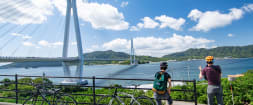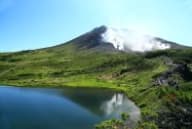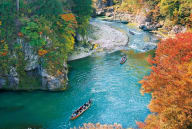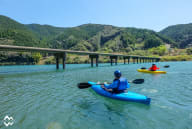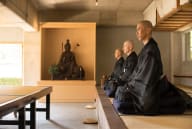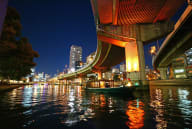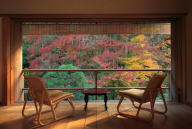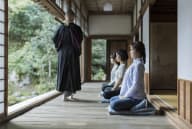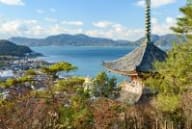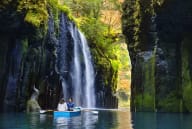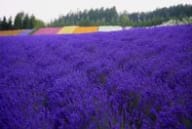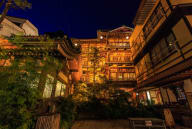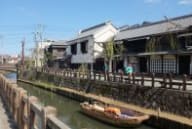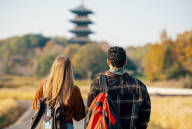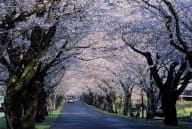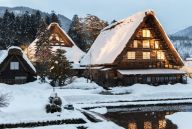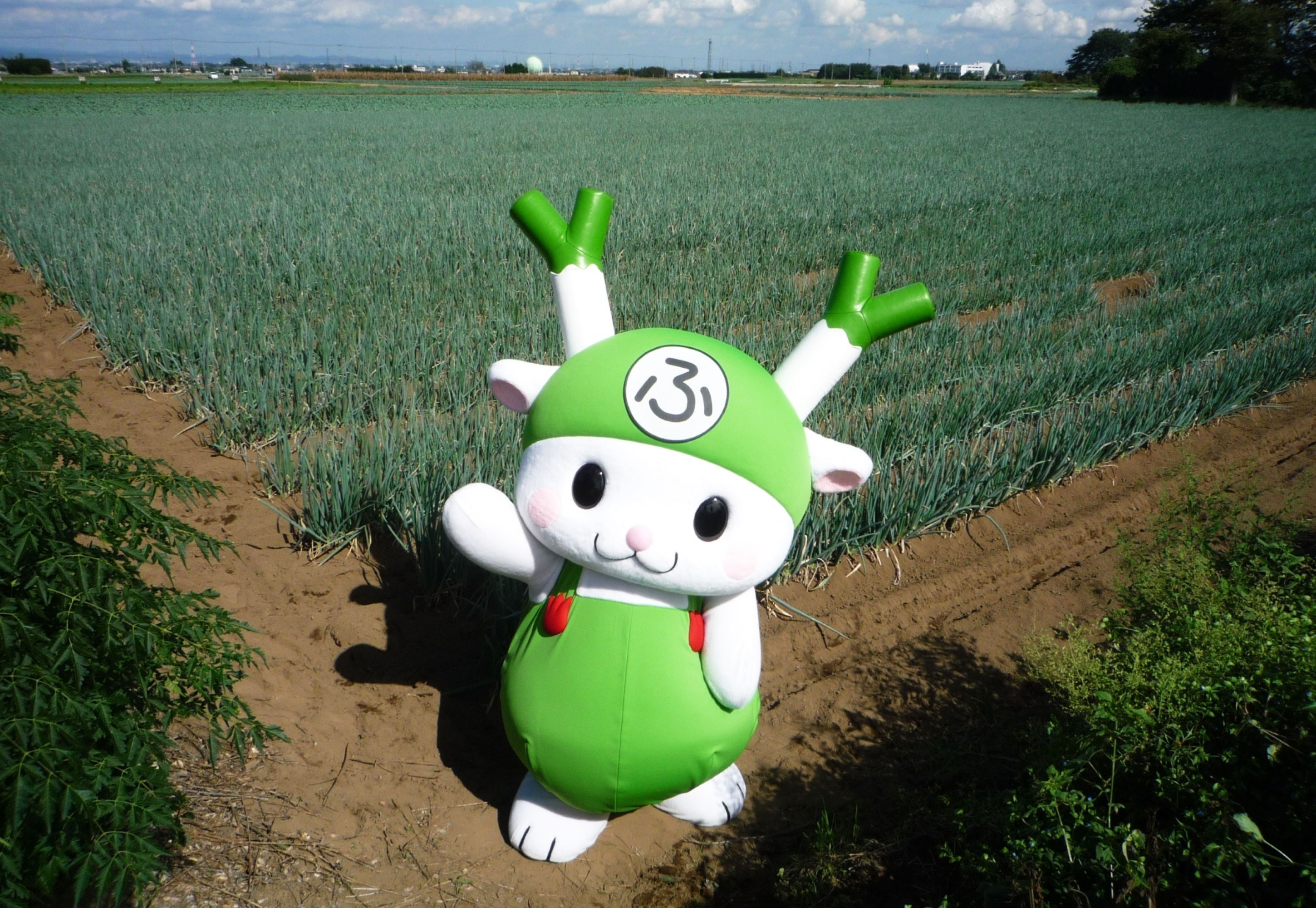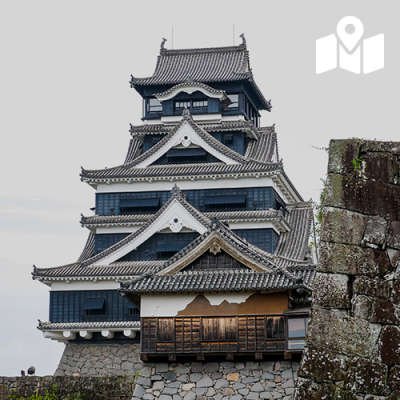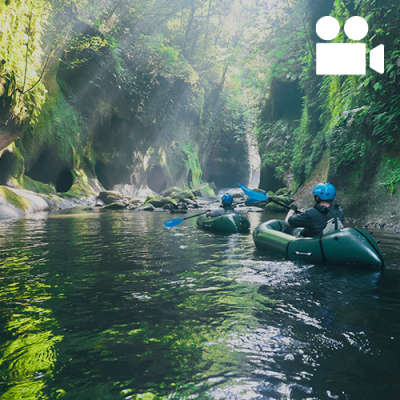Use the
Planning a Trip to Japan?
Share your travel photos with us by hashtagging your images with #visitjapanjp
“Saving Lives” is one of the key themes of Expo 2025, touching on the importance of not just promoting the well-being of humans, but preserving culture, nature, and the incredible biodiversity of the world for future generations.
The Japanese archipelago brims with natural wonders, from the vibrant coral of the Okinawa Islands to the dynamic volcanic landscapes of Kyushu. For centuries, Japanese communities have lived in harmony with nature, nurturing traditions intertwined with their surroundings.
On this trip, we visited the south part of Japan to discover some places steeped in this rich heritage and find hints for a sustainable future.
In This Article
- Takachiho Gorge: A Landscape Infused with Myth and Folklore
- Kumamoto Castle: History in Motion
- Southeast Botanical Gardens: Forest Bathing with a Tropical Twist
- Okinawa Karate Hall: Passing Down Values that Transcend Borders
- Okinawa Horse Riding Club: Roaming Beaches on Horseback
- Treeful Treehouse: Reconnecting with Nature
Takachiho Gorge: A Landscape Infused with Myth and Folklore
Miyazaki

Nestled deep in the mountains of Miyazaki, Takachiho Gorge evokes wonder with its emerald green waters, cascading waterfalls, and striking rock formations. This magical landscape has inspired countless myths and folktales since ancient times. Bearing witness to this rich history are the shrines and sacred monuments strewn along the gorge, blending in seamlessly with the surroundings. Even to this day, Takachiho’s mythic roots live on in the hearts of the locals, who reenact legends through kagura, a ceremonial dance with elaborate masks and costumes.

This boulder is featured in local legends

Visitors can observe the cliffs from the riverside promenade
“The gorge is best viewed from a rowboat, as it offers an up-close view of the cliffs and waterfalls,” explained our guide as we walked along the riverside promenade. We are told that the distinct patterns on the rock face, which takes on the appearance of dragon scales, were carved by lava flows from Mount Aso long ago. The path winds all the way to the 1,900-year-old Takachiho Shrine, passing by maples, cedars, mossy boulders, and ponds filled with carps and sturgeons. As you admire the serene views, you can’t help but marvel at how this landscape has remained unchanged for centuries and hope that it stays the same in the years to come.

Manai Falls
Kumamoto Castle: History in Motion
Kumamoto

Looming over the heart of Kumamoto City, Kumamoto Castle is a majestic structure with its steep stone walls and striking black and white facade. This landmark has been lauded as a feat of engineering, cementing its identity as one of Japan’s most iconic castles. For over four centuries, it has been in the backdrop of daily life in Kumamoto.
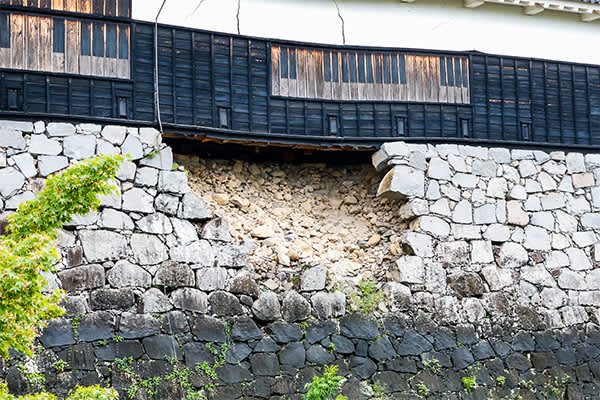
Visitors can observe sections damaged by the earthquake
A spate of massive earthquakes in 2016 caused parts of its walls and roof to collapse, leaving the castle seriously damaged. Now, it is being painstakingly restored using both traditional craftsmanship and modern technology. The work is expected to continue for the next three decades. “Instead of closing down completely, we wanted to give visitors a firsthand look at the efforts underway,” says our guide. “We also took this opportunity to add barrier-free facilities to make the castle accessible to more people.” The concept is reminiscent of the ancient Japanese art of kintsugi, in which cracks in broken pottery are not hidden, but rather showcased by mending them with gold seams.

This elevated walkway is a part of efforts to make the castle more accessible
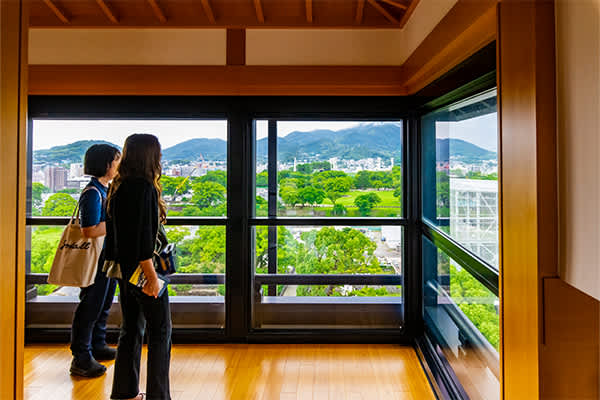
View from the top floor
An elevated walkway hemmed by ginkgo, cherry, and plum trees takes visitors to the main keep where they can learn more about the castle’s history through relics and interactive exhibits. Models and dioramas gave us a close look at the castle’s intricate design, and from the top floor, we were treated to panoramic views of the city and the mountains beyond.

At the base of the castle, you can gather alongside locals to see dance performances as well as historical re-enactments by the Kumamoto Castle Omotenashi Bushotai, a troupe attired in elaborate samurai costumes. It’s a fun way to delve into the region’s past and meet members of the community.
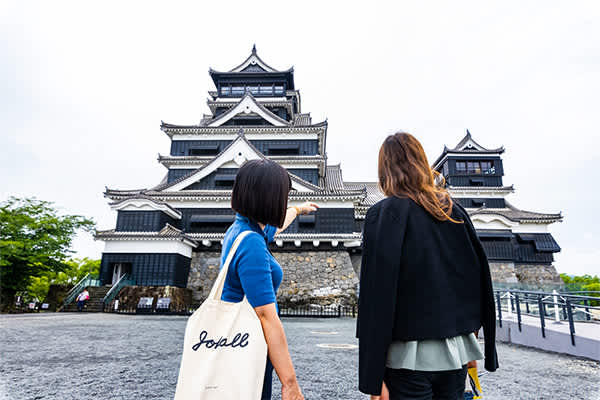
Our guide also touches on how the public has been involved in the renovation efforts through donations. “The castle has a special place in many people’s hearts, and being a part of this project brings them even closer,” she says. Kumamoto Castle has gone through many iterations over the years. Although fires and sieges have caused enormous damage in the past, it has stood the test of time. Now, as each boulder is being carefully placed back to its original place, we can see how this architectural masterpiece serves as an example of history in motion.
Southeast Botanical Gardens: Forest Bathing with a Tropical Twist
Okinawa

The Southeast Botanical Gardens were built to reforest Okinawa and enliven the local community after the Second World War. Now, it’s a living museum with over 1,000 varieties of tropical and subtropical plants from far-flung places such as Madagascar, Brazil, and the Canary Islands. You can spot rare and exotic species such as the dragon’s blood tree—one of the longest living trees in the world—known for its dark, blood-colored sap and medicinal properties.

A grove of dragon’s blood trees

The garden is filled with colorful flora
This verdant sanctuary delights all the senses—the aromas of herbs and flowers permeate the air and the entire grounds are awash with a dizzying array of colors, from vivid red hibiscus flowers to gorgeous golden-hued allamandas. As we wandered the grounds, our guide encouraged us to touch barks and seeds to feel their distinct shapes and textures, and soak in the soothing scents of tea tree and eucalyptus leaves. There was also an occasional run-in with some of the garden’s friendly residents: capybaras, goats, and parakeets.

The garden engages all the senses

Feeding a capybara
At the on-site restaurant, you can replenish yourself with a meal prepared with herbs from the garden and veggies straight from local farmers. The garden’s gelato, free of artificial flavoring and colors, is a refreshing treat on a hot day. Choose from a variety of quintessential Okinawan flavors such as mango, shikuwasa lime, and purple sweet potato.

Studies show that immersing yourself in nature can improve your overall well-being, so shinrin-yoku, or forest bathing, is often prescribed in Japan as a form of ecotherapy. In these gardens, you can do just that as you wander between shade and light under a thick canopy of tropical vegetation.
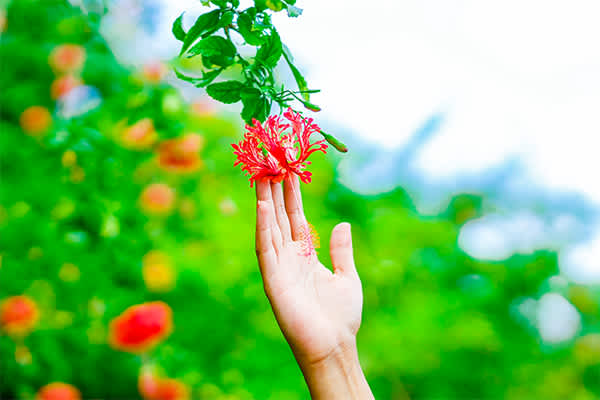
An avenue of soaring Alexander palms provides the perfect spot for a contemplative stroll. The Southeast Botanical Gardens is an homage to the biodiversity of the botanical world. It is also a great reminder of how spending time in nature can do wonders for the mind and body.
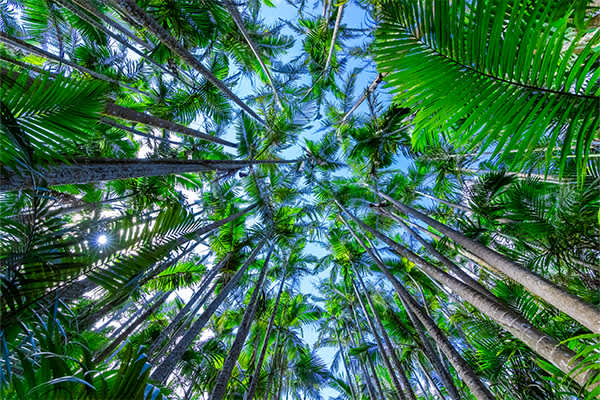
Okinawa Karate Hall: Passing Down Values that Transcend Borders
Okinawa

Karate was born in the sun-kissed islands of Okinawa. This beloved martial art is deeply rooted in the region’s history and culture, having been nurtured through cultural exchanges with neighboring countries over the centuries. The Okinawa Karate Hall was built in 2017 to foster interest in karate and pass it down to future generations.
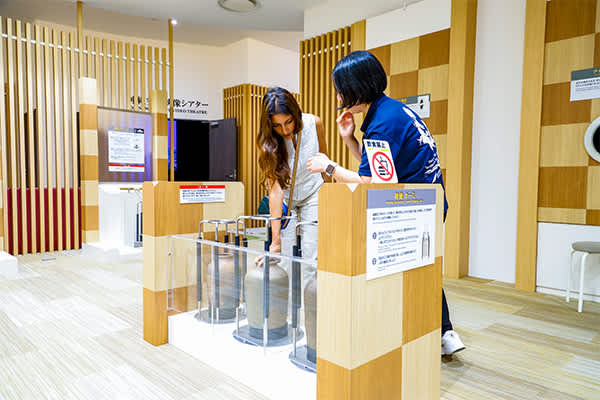
The facility houses a number of interactive exhibits
At the facility, visitors can take a deep dive into the history of karate through fascinating artifacts such as weapons and uniforms, as well as interactive exhibits that range from weighted clogs to punching machines. Newbies and enthusiasts alike can try their hand at martial arts through workshops and training sessions. Popular activities include tile-breaking using karate techniques. The crowning gem of Okinawa Karate Hall is the special dojo, with its traditional architecture and striking red-tiled roof. “We occasionally host events in which renowned karate practitioners gather here for performances,” says our guide.

What struck us the most is how there is a strong emphasis on the values of peace and respect throughout the entire facility; one plaque is emblazoned with the words, “The true master of karate need never use the techniques mastered through many years of training.” Okinawa Karate Hall not only preserves a cultural legacy, but also works to enrich the lives of people through discipline, learning, and moral principles that transcend borders.

The special jodo hosts performances by renowned practitioners
Okinawa Horse Riding Club: Roaming Beaches on Horseback
Okinawa

Okinawa is known for its crystalline waters and beautiful stretches of sandy beach. Horseback riding offers a great way to experience these vistas from a unique vantage point. The Okinawa Horse Riding Club, set in the laidback village of Yomitan, is home to a band of equines with quirky names such as Whiz and Goose. We were introduced to Goody—a friendly and docile mare with a hefty appetite. After mounting Goody, we made our way to a secluded beach speckled with seashells and tropical plants. Moving at a gentle trot, you can feel the refreshing sea breeze and take in the picturesque views at an unhurried pace.

Goody the mare

Making our way to the beach
Visitors can even choose to take a dip in the sea with the horses. “Seeing the horses frolic in the water always brings a smile to people’s faces,” our guide mentions. “Once you spend enough time with them, you can get to know each of their unique personalities,” she adds with a smile. Whether you’re a seasoned equestrian or a curious first-timer, interacting with horses in such a stunning natural setting can be an incredibly therapeutic activity.

Treeful Treehouse: Reconnecting with Nature
Okinawa
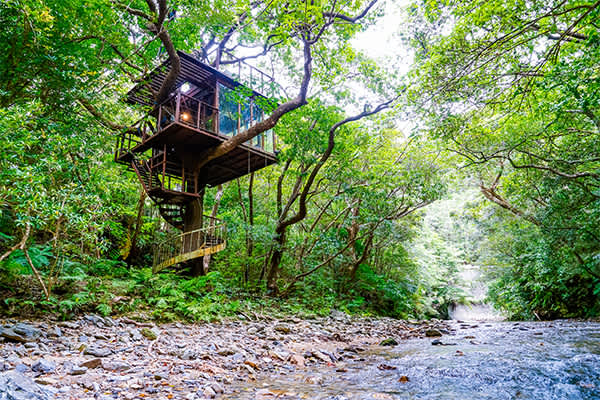
A long drive through a winding mountain path in Yambaru took us to Treeful Treehouse Sustainable Resort—a whimsical forest getaway that looks like something right out of a fairytale. The cluster of treehouses here is built around the natural landscape—tree trunks jut straight through the rooms, and a maze of woody stairs, bridges, and walkways zigzag between sun-dappled evergreens. Let time slip away as you watch butterflies flit around, serenaded by birdcalls and the peaceful gurgles of the stream. Treeful Treehouse truly blurs the lines between man and nature.

The owner of the resort says that it was a childhood dream of his to build a treehouse, “When I first saw the beautiful akagi tree upon which our Spiral Treehouse now sits, I gave it a big hug.”

The resort’s resident goat, Donna
Treeful Treehouse is a model of sustainability. In addition to relying solely on renewable energy, it takes special steps to preserve biodiversity and ensure that the undergrowth gets ample sunlight and rainwater. Each treehouse has a distinct design, taking inspiration from nature and traditional Japanese architecture. Playful touches like hammocks and swings add to the charm.

Bonfire dinner
If you’re feeling adventurous, join a buggy tour that will take you to the wildest parts of Yambaru National Park. Learn more about the local wildlife—such as the rare and endangered Okinawa rail— as you go from jungles and waterfalls to soaring seaside cliffs.

Guests at the resort can enjoy a hearty dinner prepared with fresh, locally-sourced ingredients around a cozy bonfire. As you explore the grounds, don’t forget to say hello to the resident goat, Donna—and maybe hug a tree or two.

Conclusion
This journey was packed with fascinating encounters and a fresh outlook on the importance of traveling with purpose. Mindful travel can take many forms, whether it’s riding a horse by the sea, partaking in martial arts, or just exploring a tranquil forest. Both Okinawa and Kyushu Island have plenty to offer for those eager to discover more about the natural landscapes and enduring traditions of Japan—and contemplate on how each of us can play a part in safeguarding these treasures for the future.














